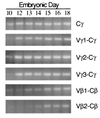Characterization of avian T-cell receptor gamma genes
- PMID: 8986811
- PMCID: PMC26404
- DOI: 10.1073/pnas.93.26.15329
Characterization of avian T-cell receptor gamma genes
Abstract
In birds and mammals T cells develop along two discrete pathways characterized by expression of either the alpha beta or the gamma delta T-cell antigen receptors (TCRs). To gain further insight into the evolutionary significance of the gamma delta T-cell lineage, the present studies sought to define the chicken TCR gamma locus. A splenic cDNA library was screened with two polymerase chain reaction products obtained from genomic DNA using primers for highly conserved regions of TCR and immunoglobulin genes. This strategy yielded cDNA clones with characteristics of mammalian TCR gamma chains, including canonical residues considered important for proper folding and stability. Northern blot analysis with the TCR gamma cDNA probe revealed 1.9-kb transcripts in the thymus, spleen, and a gamma delta T-cell line, but not in B or alpha beta T-cell lines. Three multimember V gamma subfamilies, three J gamma gene segments, and a single constant region C gamma gene were identified in the avian TCR gamma locus. Members of each of the three V gamma subfamilies were found to undergo rearrangement in parallel during the first wave of thymocyte development. TCR gamma repertoire diversification was initiated on embryonic day 10 by an apparently random pattern of V-J gamma recombination, nuclease activity, and P-and N-nucleotide additions to generate a diverse repertoire of avian TCR gamma genes early in ontogeny.
Figures





References
Publication types
MeSH terms
Substances
Associated data
- Actions
- Actions
- Actions
- Actions
- Actions
- Actions
- Actions
- Actions
- Actions
- Actions
- Actions
- Actions
- Actions
- Actions
- Actions
- Actions
- Actions
- Actions
- Actions
- Actions
- Actions
- Actions
- Actions
- Actions
- Actions
- Actions
- Actions
- Actions
- Actions
- Actions
Grants and funding
LinkOut - more resources
Full Text Sources

